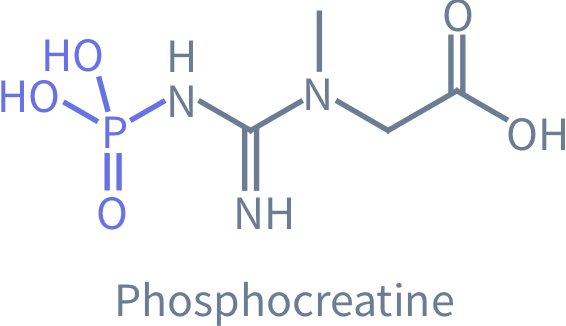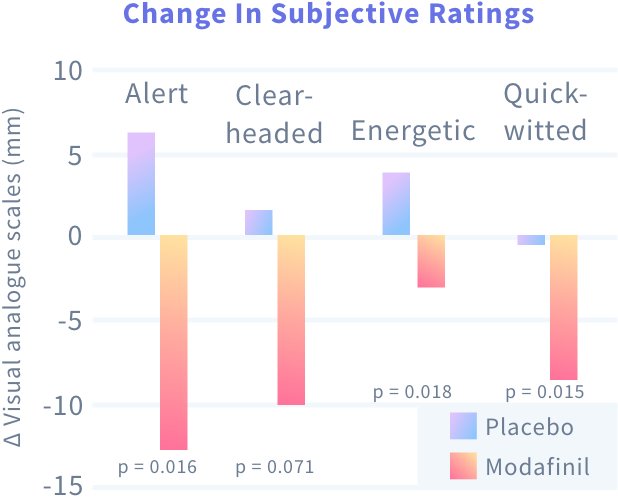Must Reads
- Modafinil Enhances Attention and Alerting Performance in Healthy Volunteers
- Where To Get Modafinil Online - Vendor Comparison Chart
- 5 Tips For Beating Modafinil-Induced Anxiety
- 5 Ways To Combat Modafinil Tolerance
- 🔥AfinilExpress Review🔥 If You Read One Article About AfinilExpress, Read This One
- Where To Buy Modafinil Online in 2019
Subjects with the modafinil treatment were significantly more alert, energetic, and quick-witted compared to those with the placebo treatment.
So say Suzuki and colleagues1 in their recently published a study on the effects of modafinil in healthy volunteers.
Suzuki's study had three parts:
- The brains of healthy adults given placebo or modafinil were scanned using functional magnetic resonance imaging (fMRI).
- During the scans, participants completed an attention network test (ANT) task to tease out modafinil's effects.
- The participants were asked to report various dimensions of their mood before and after treatment (e.g., "energetic", "tranquil", and so forth).
Suzuki's findings?
Modafinil treatment boosted accuracy and reaction times in the attentional network test. Modafinil also increased signal strength in brain regions that modulate attention (left middle and inferior occiptal gyri) and increased subjective ratings of alertness, energy, wit, and vigor.
What Motivated The Study?
Whenever I'm reading a paper I ask myself "what question do these experiments answer?"
As you would expect, the rational for Suzuki's modafinil study is right in the abstract:
...However, neural substrates underlying the modafinil effects on attention are not fully understood.
Many drugs are well-characterized but modafinil is not one of them. A quick look at the wikipedia entry for amphetamine will tell you that the mechanism of action of amphetamine is extremely well characterized. Not so for modafinil.
You can sense that modafinil remains a pharmacological enigma by scanning reviews of modafinil's mechanism.
Modafinil boosts arousal, so it's natural to think that it would increase the activity of catecholamines (e.g., dopamine). That's technically true, but modafinil's affinity for the dopamine transporter is low and possibly clinically negligible2.
Most discussions about modafinil's mechanism suggest that there is no unitary mechanism: modafinil hits too many neuronal targets. For example, Gerrard and Malcolm3 review the role of orexin, gap junctions, adenosine, catecholamines, glutamate, GABA, and other substrates in modafinil's effects. But it's unclear which of these neuronal targets are essential for modafinil to work.

At one point in their review, Gerrard and Malcolm suggest that modafinil might work by regenerating the phosphocreatine pool. For those out of the loop, phosphocreatine is a high-energy compound that replenishes ATP reserves when cerebral ATP is depleted. This idea is pretty tenuous - it's only based on one study5 and lots of speculation. But its speculativeness underscores how difficult it's been to pin a mechanism to modafinil.
The Tripartite Attention System
Posner and Petersen4 proposed that the "attention system" can be subdivided into three networks:
- alerting - maintaining awareness to stimuli
- orienting - information from sensory input
- executive control - conflict resolution
You might think that these three networks are just heuristics or constructs to better understand the brain. It turns out that the three networks reflect physical reality: they are in fact functionally and anatomically segregated.
Norepinephrine controls the alerting network, acetylcholine controls orienting, and dopamine modulates - you guessed it - executive control.
A Role For Norepinephrine?
Suzuki et al. ultimately suggest that the effects of modafinil on the alerting network are mediated by norepinephrine. This makes some sense given that norepinpehrine is known to govern the alerting network7.
But I'm not sure how the authors reconcile this idea with modafinil's admittedly weak occupancy of dopamine and norepinephrine transporters (NETs)8 in vivo.
For example, the IC50 of modafinil for NET is 35.6 μM vs 0.122 uM for atomoxetine, a norepinephrine-reuptake inhibitor. In other words, atomoxetine's affinity for the norepinephrine transporter is 291x as strong as modafinil's.
Modafinil and The Attentional Network Test (ANT)
Suzuki's group had participants do an ANT or attention network test to measure these three distinct attentional networks (alerting, orienting, executive control) during the fMRI scan.
Modafinil increased reaction times and improved accuracy compared to placebo.

During the attentional network test, both modafinil and placebo groups showed altering network activity in the following brain regions:
- left inferior temporal gyrus
- bilateral middle occipital gyri
- right inferior occipital gyrus
- bilateral laterla temporo-occipital cortices
- bilateral cerebellum
But the modafinil group diverged from the placebo group with activation of the left middle temporal gyrus, right inferor temporal gyrus, and left inferior occipital gyrus.
More strikingly, modafinil administration resulted in significantly (p < 0.001) stronger activation in the left middle and inferior occipital gyri than placebo. In the placebo cohort, no brain regions showed greater alerting network activity than in the modafinil group.
Effects of Modafinil on Self-Reported Mood

Modafinil treatment significantly enhanced alertness, energy, wit. The effect on clear-headedness almost reached significance (p = 0.071).
Unexpectedly, modafinil treatment did not significantly worsen self-reported tension/anxiety, calmness or tranquility. Modafinil is known to exacerbate anxiety in some people.
Here's the summary from the paper:
Changes in subjective ratings were calculated by subtracting the values before the drug administration from those at 2 h after the drug administration. There were no significant drug effects on the depression status as measured by HAM-D (p = 0.147) or the anxiety status as measured by HAM-A (p = 1) between the placebo and modafinil treatments. With regard to mood states as measured by POMS (Table 2), modafinil treatment demonstrated a significant increase in the score for vigor compared to the placebo treatment (p = 0.021). With regard to subjective mood as measured by VAS (Table 2), subjects with the modafinil treatment were significantly more alert (p = 0.016), energetic (p = 0.018), and quick-witted (p = 0.015) compared to those with the pla- cebo treatment. Among the three mood factors, the modafinil treatment resulted in a significant increase in alertness factor compared to the placebo treatment (p = 0.005). The results were consistent with previous reports (Pringle et al. 2013; Rasetti et al. 2010). Thus, the results from subjective ratings confirmed that the modafinil treatment increased vigor and alertness.
Summary
In a double-bind, placebo-controlled fMRI study Suzuki et al. report that modafinil:
- enhances alerting performance
- increases activation in the occipital lobe in the alerting network
- improves self-reported energy, wit, alertness, and lucidness
The authors also suggest that the alerting effects of modafinil may be mediated by increased noradrenergic activity in the occipital cortex through the inhibition of noradrenaline re-uptake.
These results further support the benefits of modafinil in ADHD and schizophrenia6.
References
-
Ikeda Y, Funayama T et al.. Modafinil enhances alerting-related brain activity in attention networks. Psychopharmacology (Berl). 2017 Apr 3;(): ↩
-
Mignot E, Nishino S et al.. Modafinil binds to the dopamine uptake carrier site with low affinity. Sleep. 1994 Aug;17(5):436-7 ↩
-
Gerrard P, Malcolm R. Mechanisms of modafinil: A review of current research. Neuropsychiatr Dis Treat. 2007 Jun;3(3):349-64 ↩
-
Petersen SE, Posner MI. The attention system of the human brain: 20 years after. Annu Rev Neurosci. 2012;35():73-89 ↩
-
Pierard C, Satabin P, et al. Effects of a vigilance-enhancing drug, modafinil, on rat brain metabolism:2D COSY 1H-NMR study. Brain Res. 1995;693:251–6. ↩
-
Scoriels L, Jones PB et al.. Modafinil effects on cognition and emotion in schizophrenia and its neurochemical modulation in the brain. Neuropharmacology. 2013 Jan;64():168-84 ↩
-
Green AE, Munafò MR, DeYoung CG, Fossella JA, Fan J, Gray JR (2008) Using genetic data in cognitive neuroscience: from growing pains to genuine insights. Nat Rev Neurosci 9:710–720. doi:10. 1038/nrn2461 ↩
-
Madras BK, Xie Z et al.. Modafinil occupies dopamine and norepinephrine transporters in vivo and modulates the transporters and trace amine activity in vitro. J Pharmacol Exp Ther. 2006 Nov;319(2):561-9 ↩
